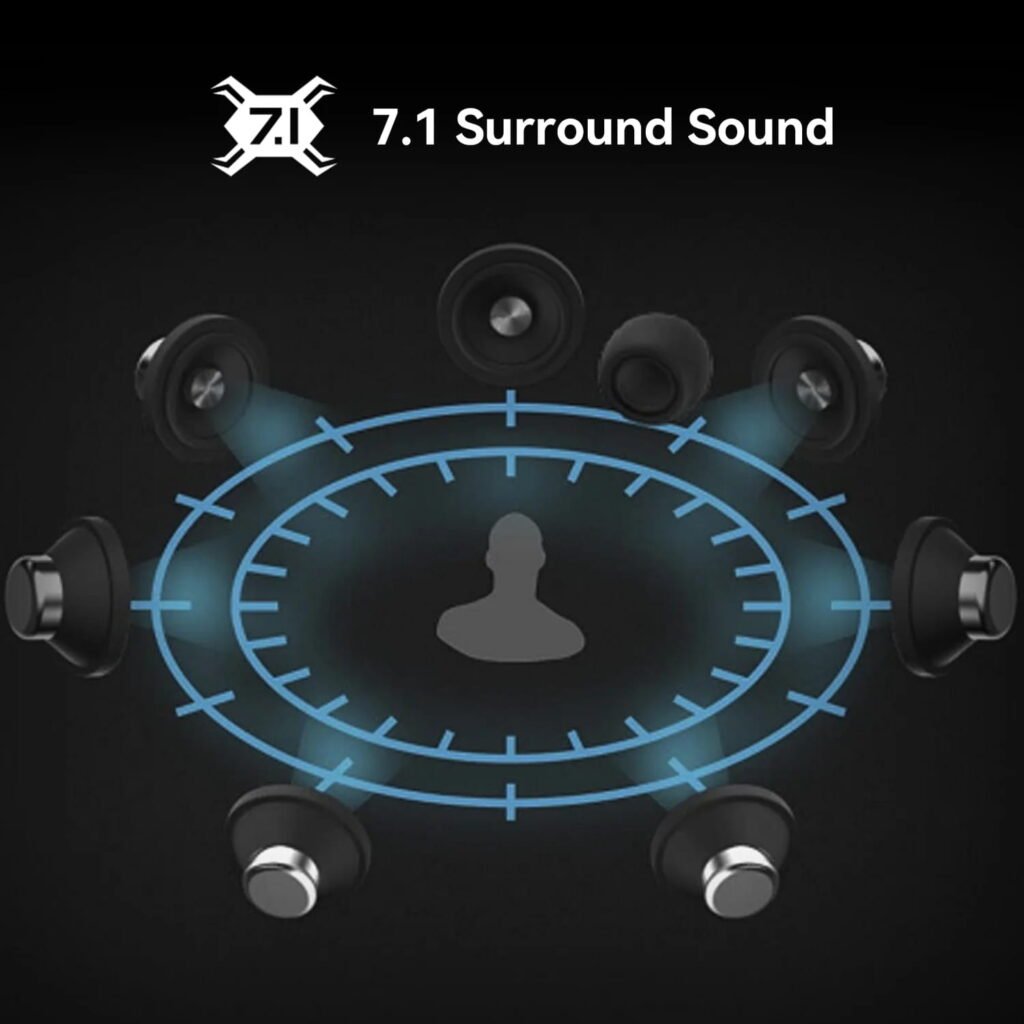It happened again last month. A friend messaged me a link to a shiny new gaming headset, proudly advertised as having “full 7.1 surround sound.” He wanted to know if he should grab it right away. My reply was a long voice note because this topic is trickier than the marketing makes it look. If you have ever stared at that mysterious 7.1 label and wondered whether it is magic or marketing, this guide is for you.
Table of Contents
I spent the better part of two weeks swapping between my everyday stereo cans and a set of virtual surround headphones, plus I dusted off my old living room speaker rig for a reminder of how real surround feels. What follows is not a white paper. It is a field report: plain language, first hand impressions, and a few tips I wish someone had given me when I started chasing extra channels.
Why the Numbers Matter
Let us clear up the math right away. A 7.1 system promises eight separate audio channels. Seven of them carry ordinary full range sounds, and the last one, the “point one,” handles only deep bass.

Think of the seven channels as voices in a choir and the subwoofer as the kick drum that gives every chorus a little punch.
The seven main voices usually line up like this:
- Front Left
- Front Right
- Center (mostly dialogue or the main melody)
- Side Left
- Side Right
- Rear Left
- Rear Right
Add the subwoofer in the corner of the room, and that is a 7.1 layout. In a living room setup with stand mount speakers, you physically hear bullets whizz left to right or cars roar past your sofa because the soundtrack is literally split between those boxes. In headphones, things get more creative, but we will reach that in a moment.
A Quick Memory from the Couch
The first true seven speaker system I heard was a friend’s home theater build back in 2014. We threw on Interstellar just to test the launch scene. When the rocket engines kicked, the rear surrounds shook a loose windowpane. It felt like the room flexed around us.

That was the day I realised surround sound is about pressure and placement as much as raw volume. It is not louder by default; it is simply everywhere at once.
True Surround vs Virtual Surround
Nobody is hauling eight speakers onto a bus ride, so headphones cheat. They rely on virtual surround, software tricks that fool your brain into hearing depth and direction from only two drivers, left and right.
I fired up three common options during my tests:
- Dolby Atmos for Headphones on Xbox and Windows
- DTS Headphone:X inside an older HyperX Cloud dongle
- Windows Sonic which is built straight into Windows 10/11
Each uses slightly different signal processing, but the goal is the same: change how fast and how strong certain frequencies reach your ears so your brain thinks a footstep happened behind you, even though both ear cups are doing the heavy lifting.
Is It Convincing?
Sometimes, yes. I played three rounds of Rainbow Six Siege with Atmos enabled and immediately picked up the soft clatter of an enemy dropping a breach charge on the floor above me. I would have sworn the sound came from eight o’clock behind my left shoulder. When I toggled virtual surround off mid round, that same cue flattened into a vague left channel thump. In competitive shooters, those small position hints are gold.
Other times the software overdoes the effect. Watching Parks and Recreation with DTS processing turned on felt like everyone was talking from inside a tiled bathroom. Comedy does not need epic reverb. I switched back to stereo in five minutes.
So Is One Better Than the Other?
A physical 7.1 speaker setup wins for realism. There is zero processing guesswork. You get discrete, dedicated channels hitting your ears from their own positions in space. The trade off is cost, space, and neighbour complaints. Virtual surround is cheap, portable, and good enough for gaming once you dial in a profile you like. For music, I usually flip it off because studio albums are still mixed in two channels.
Everyday Listening Tests
I kept a small journal while swapping headsets at home, on the tram, and during a weekend visit to my parents. Here are the raw notes, trimmed for clarity.
Gaming Session: Friday Night

Title: Valorant ranked queue
Gear: Logitech G Pro X with G Hub surround on
Result: Could track footsteps around corners. One clutch defuse because I heard a reload to the right of a box stack. Bass felt a tad hollow, though.
Commute: Monday Morning
Title: Blade Runner 2049 soundtrack
Gear: Sony WH-1000XM3 in plain stereo
Result: Stereo kept the synth pads dense and tight. Virtual surround in the same headphones (using the phone’s Dolby app) made the low end bloom too wide, lost impact. Went back to stereo after two tracks.
Living Room Movie: Saturday
Title: Mad Max: Fury Road Blu ray
Gear: Old Onkyo AVR with 7.1 bookshelf speakers
Result: The war rig engines rolled from rear left to front right as the camera panned, and my pulse followed. Zero virtual trickery could match that shake.
Zoom Meeting: Tuesday Afternoon
Gear: Corsair HS80 with surround off
Result: Voices felt clearer in plain stereo. Surround added a tiny hall echo that made co workers sound like they were in a gym.
Takeaway? Use the feature selectively. Flip it on for shooters or blockbuster nights, and keep stereo for playlists or calls.
Pros and Cons, Plain and Simple
Why You Might Love 7.1
- Better positional cues in games
- Bigger sense of space in action movies
- Often bundled free with gaming headsets
Why You Might Skip It
- Can muddy music or dialogue
- Software quality varies wildly
- Real hardware setups are expensive and bulky
Buying Tips That Saved Me Money
- Check for a toggle. Any headset worth its salt lets you disable virtual surround. If the on off switch is buried or missing, walk away.
- Read user forums. Gamers are brutally honest. If a surround profile smears footstep audio, Reddit will know.
- Test with familiar scenes. I use the bank heist intro of The Dark Knight. I know exactly where the glass shatters in that opening shot. If a headset moves that sound somewhere weird, I lower the rating.
- Mind the mic. Many gaming headsets skimp on microphone clarity. If you stream, a separate USB mic plus a solid stereo headset might beat an all in one 7.1 unit.
- Don’t chase numbers alone. Higher channel counts look cool, but driver quality and comfort last longer than any logo.
Final Thoughts
Surround sound is like adding seasoning to food. Too much, and the meal feels off. Too little, and it tastes flat. After two weeks of swapping gear and annoying my neighbours with movie explosions, I landed on a simple rule:
Keep stereo as your baseline, and add 7.1 only when the content asks for it.
If you are a competitive gamer or a film buff with space for speakers, surround pays off instantly. If you mostly listen to music or join conference calls, a comfortable pair of stereo headphones will serve you better.
Audio should fit your life, not the other way around. Choose what serves the moment, and never be afraid to hit the off switch.
Frequently Asked Questions I Get in DMs
Does 7.1 work on consoles?
Yes, both PlayStation 5 and Xbox Series support licensed virtual surround apps. You usually plug the headset dongle into a USB port and select the format in system audio settings.
Can I upgrade a 5.1 speaker kit to 7.1 by buying two extra speakers?
Sometimes. Your receiver needs to support 7.1 output. If it does, matching rear pairs should blend in. Check the manual first.
Is Atmos the same as 7.1?
Atmos can include height channels above your head, so it can act like 7.1 plus extra. Think of 7.1 as a subset inside Atmos.
Do I need an external amp for planar magnetic 7.1 headphones?
Virtual 7.1 headsets are almost always dynamic drivers, so any phone or USB dongle feeds them fine. Planars are usually stereo only and may need an amp.